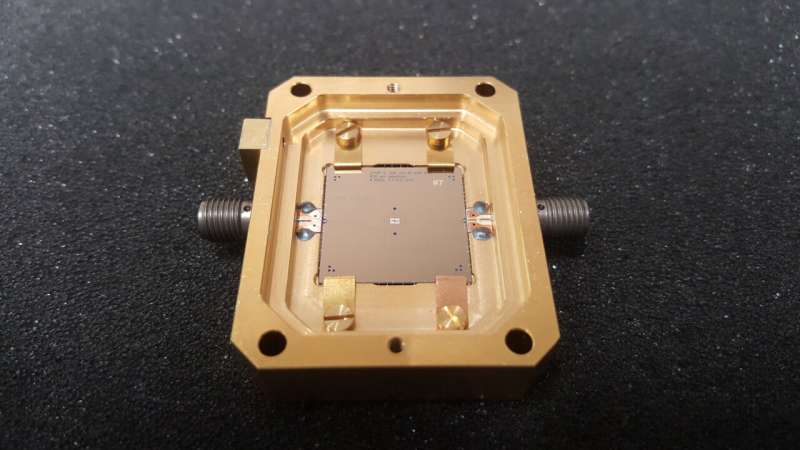Spectral resolution of superconducting single photon detectors more than doubled

Scientist use superconducting detectors (MKIDs) to capture single photons coming from exoplanets. MKIDs constantly monitor their own kinetic inductance, which changes proportionally to the energy of an incoming photon. Researchers from SRON Netherlands Institute for Space Research have now more than doubled their spectral resolution by re-trapping most of the leaked energy. The research was published in Physical Review Applied.
In a superconductor at low temperature, most electrons live in pairs. An oscillating current accelerates and decelerates these pairs, giving rise to an effect called kinetic inductance. When a photon strikes a superconductor, its energy cascades through the material, breaking up thousands of electron pairs. A lower density of pairs means a higher kinetic inductance.
Scientists use this property to detect single visible and near-infrared photons, for example from exoplanets, by building superconducting single-photon detectors in the shape of microwave resonators, called Microwave Kinetic Inductance Detectors (MKIDs). These detectors constantly measure the kinetic inductance of their material and deduce if a photon has hit. And if so, with what wavelength, so that each pixel can also measure a spectrum. Pieter de Visser at SRON Netherlands Institute for Space Research and colleagues have now modified the design of MKIDs to achieve a 2.5-fold increase in the precision with which the device can measure a photon's wavelength.

Currently, conventional single photon detectors are superconducting circuits, deposited on a thick (>300 μm) silicon or sapphire substrate. The spectral resolution of these detectors is limited, because part of the initial energy from the detected photon can leak away into the substrate through acoustical waves—phonons— before it is registered. This energy loss increases the statistical variance of the kinetic-inductance signal used to detect a photon, which broadens the measured spectrum.
In their redesigned device, De Visser and his colleagues replace the substrate with a thin (110 nm) silicon-nitride membrane. They show that phonons escaping from the superconducting wire into this membrane reflect from the membrane's bottom surface back into the superconductor. There they finish their job breaking up more electron pairs. The researchers experimentally achieved resolving powers of 52 and 19 for optical and near-infrared photons, respectively. For conventional MKIDs these numbers were 21 and 10.
They now plan to address two challenges. Firstly to reach even higher spectral resolution by stronger phonon-trapping, using so-called phononic crystals. Secondly to apply this method to devices with many pixels, to create instruments suitable for astronomical and biological applications, such as studying exoplanet atmosphere and fluorescence measurements of biological samples.
More information: Pieter J. de Visser et al, Phonon-Trapping-Enhanced Energy Resolution in Superconducting Single-Photon Detectors, Physical Review Applied (2021). DOI: 10.1103/PhysRevApplied.16.034051
Provided by SRON Netherlands Institute for Space Research




















